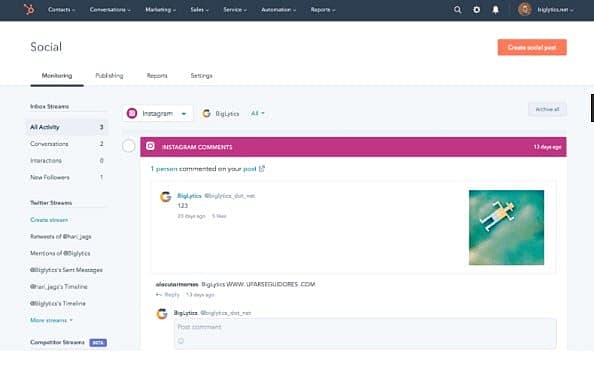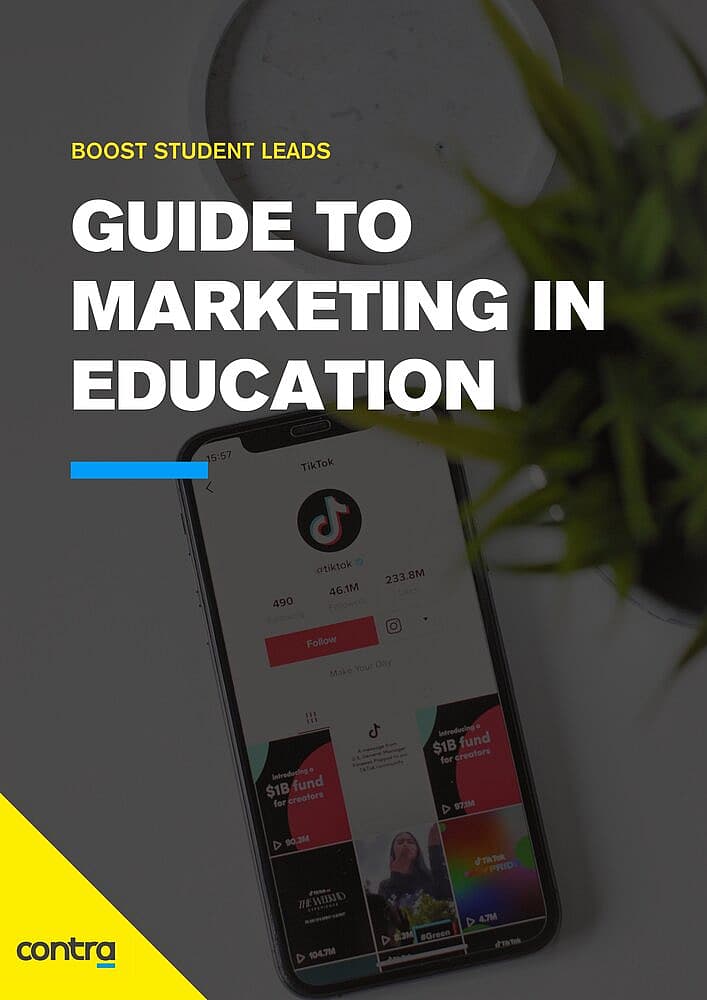Marketing in Education: Using social media to boost student leads
25.04.2021
Marketing in Education requires an omnichannel approach, with prospective students interacting with your Education institution across multiple media before enrolling. Social media serves as the perfect platform to showcase your brand and give prospective students a taste of life at your college/university.
However, the battleground for the hashtag, retweet, like or share is intense so how can you stand out from the other institutions competing for eyes and ears?
Again this comes back to being helpful, authentic and relevant – with a dash of out of the box thinking. Your social media strategy needs to be joined up with your other marketing output in a way that promotes the very best you have to offer.
For example, if you are wanting to promote a great facility you have (e.g a science department that has made great breakthroughs in research), then look for ways that your social voice amplifies this.
Look for stories of breakthroughs that are already “out there” on social media and look for possible tie-ins to your own social, email and blog content and so on.
The debate – particularly with reference to Millennials and Gen Z – is whether to disrupt or align with their social media activity.
You need to get your message heard but there is a fine balance to strike so you don’t appear too pushy. The holy grail of social media engagement is collaboration. This is where your student voice becomes all the more important.

1. Student ambassadors are key to marketing in Education.
Existing students can be your strongest advocates (and your worst critics). A good social media campaign needs to understand the voices of your students, harness them and show what you do to work with them.
There are some great examples of student led campaigns out there but a few that spring to mind are Leeds Beckett’s “100 days to go Freshers Countdown!” which provided advice to new students on unique activities they could do on each of the 100 days leading up to Fresher’s week. The results of this accounted for almost 10,000 new page views.
The University of Salford ran their #Salfie Campaign where Polaroid-style frames were hung around the university campus. Heart templates were included in welcome packs and students were encouraged to take a selfie with the frames and post on social media with the hashtag #Salfie. This was incentivised with a competition for best photo.
The University of Sheffield’s #WeAreInternational Campaign encouraged students to spot posters and banners across the campus and post their pictures on social media using the hashtag. This was timed during the EU referendum which had seen feelings of xenophobia rising in the media. In a survey by QS Enrolment Solutions, 67,000 prospective international students were surveyed of whom 29,020 were considering studying in the UK – 82% said that the #WeAreInternational campaign positively influenced their perceptions of studying in the UK.
Some years back, our own BeCambridge campaign sought to break down the perceived barriers to joining an “elite” university. Content was generated by a diverse range of student ambassadors who faced perceived barriers to entry like ethnicity, socioeconomic status, geography, religion and even mental health challenges. This took an omnichannel approach and encouraged students to interact using the hashtag #becambridge.
What all of these campaigns share is that they are student-led. Marketing in Education is all about your students they’re the most valuable marketing team you could ever have.
2. Build a social community.
Once students are attracted and are using these channels, the hard work is almost complete. But, I hear you ask, what about the detractors? The beauty of social platforms is that they are open to all. That means all opinions can be voiced – positive and negative. The reason I encourage social media engagement is that debate is (mostly) healthy.
If a prospective or existing student airs particularly negative views towards your college or university, there is a strong chance that your advocates will challenge their views openly.
If not, then you have the opportunity to step in and perhaps highlight the ways you are there to support them. I would recommend however that this comes from an admissions or pastoral care department rather than someone in marketing.
Remember also, that if you keep hearing the same negative comments, it’s probably time to do something about it. If you come up with a winning strategy that addresses issues, social channels are a great place to demonstrate this.
Community management is vital for organisations in the Education sector, where the audience is largely young, opinionated and social-savvy – and there’s a lot of them. Tools like HubSpot allow you to centralise your social channels and manage all your social interactions in one place.
You can stay on top of social conversations, new followers, interactions and much more while posting across channels using just one tool.

3. Engage in existing conversations.
There are many tools out there that will help you figure out what’s important to your different student personas. Social media marketing in Education is as much about listening to your audience as it is talking to them.
Social listening apps like Critical Mention or SEMrush can help you evaluate how your earned media is performing. CRM tools like HubSpot allow you to link popular marketing tech tools together to give a richer understanding of motivations and views of your prospective and existing students.
Even without these tools, it isn’t too difficult to find out what conversations are trending on Twitter, Medium or Facebook. Simply type “University Name” or #CollegeName in to one of these platforms and you’ll see hundreds if not thousands of conversations that you or your student ambassadors can contribute to.
Again, look for ways that you can truly add value – address needs with genuine solutions.
4. Find your influencers.
We all know the value of getting mentioned by influencers on social media channels. Influencers have built authority in a given subject area and usually have thousands of disciples who will follow and act upon their advice.
The trouble is these influencers are notoriously hard to, well, influence! If they generally agree with your messaging then you stand a chance of getting an @mention or even a link to your site but the chances are slim (especially given the similarities you may share with competitors). So, should we give up on influencers altogether?
Our answer is, no! The key here is to understand the difference between different types of influencer. Macro Influencers (the one’s many marketers target), are household names. Businesses target them to feature their product or service on their social media profiles with a contextual caption mentioning their brand. They will then promote this to millions of people.
Micro influencers are normal people that usually have 500-10,000 followers. They are still hard to reach but are more likely to promote lesser known brands. A strategy here is to look through your alumni, and see if any of them has made a particular impact on the world (whether through research, the arts, media or whatever).
See if there are ways that you can highlight their positive influence on society (remember how Loughborough University did this with #LboroFamily?). Existing students – who aren’t ambassadors as such – may also be highly active on social channels.
There are apparently also nano-influencers but the experts point out they aren’t experienced in working with brands and so have the potential to decrease its value.
The musician, Example, attended Royal Holloway University and regularly went back to play at their Summer Ball and other gigs throughout the year. He actively pushed this news and related content out through his social channels which focused thousands of young eyes on the gorgeous campus buildings and incredible Summer Ball scenes.
And don’t underestimate the power of TikTok for capturing Gen Z’s attention. Tik Tok released ‘branded missions’ in 2022. This harnesses the power of User Generated Content (UGC) to attract your audience.
In three simple steps, you can gain access to some of the most influential content creators on TikTok that already have a captive student audience.
- You set your “Branded Mission” (the kind of content you want people to create) and the app briefs creators that are a fit with your university.
- Creators submit their videos.
- The highest-performing videos are boosted as sponsored ads.
5. Advertise on social channels.
When devising your strategy, keep in mind the intrinsic benefits and drawbacks of each social channel. Also consider the pros and cons of paid advertising on each platform. After all, you’re looking to get your brand message into the right places.
Here are a few popular social platforms and their pros and cons for ad targeting.
| Platform | Pros | Cons |
|
|
|
|
|
|
|
|
|
|
|
|
| YouTube |
|
|
| Snapchat |
|
|
Conclusion.
Social media marketing in Education is an enduring way to connect and create community with past, present and future students.
The key to success in this space is to engender a sense of authenticity and effectively manage your community.
The more your student community engages with your messages, the more likely they are to promote your college or university positively. Treating participants as individuals wherever possible will help turn detractors into advocates – particularly if you solve a genuine challenge that they have. The main point is to see social media channels in the round – they aren’t likely to win over a student population in isolation but can go a long way towards identifying key trends that you need to align with, or challenge. Remember also the power of influencers – spend as much time as possible identifying these individuals and use their profiles to actively engage with social conversations that are already happening.
Check out the last blog in this series, ‘Boosting student leads through marketing automation‘.
DOWNLOAD GUIDE
Download the most comprehensive guide to marketing in the education sector now.
The definitive guide to marketing in Education
This 212-page guide includes:
- Advice from leading industry figures
- Real-world case studies
- A step-by-step approach to build your Education marketing strategy


